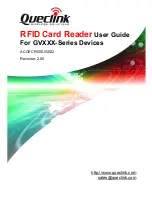
Chapter 12 Statistics Screens
Management Switch Card User’s Guide
449
12.11.4.7 1day DSL Line Performance
To display line performance counters for the past one day, click the port number in the line card’s
statistics screen (see
) and click the
1day
tab.
TimeElapsed
shows how long the port’s downstream and upstream connections have been up
during the current day.
MonitoredTime
shows how long the port’s downstream and upstream connections have been up
during a previous day.
FailFulInit
These are the DSL line’s downstream and upstream numbers of initialization failure
traps that have occurred within the current 15 minute period.
ChanCorrectedBlks
These are the numbers of corrected blocks for downstream and upstream
transmissions.
UnCorrectedBlks
These are the numbers of uncorrected blocks for downstream and upstream
transmissions.
CodeViolations
These are the numbers of incorrect cyclic redundancy checks that have occurred
within the current 15 minute period.
RtxCw
These are the numbers of RS (Reed-Solomon) codewords or DTUs (Data Transfer
Units) retransmitted through PhyR or G.INP retransmissions within the current 15
minute period.
RtxCorrectedCw
These are the numbers of RS codewords or DTUs that have been corrected through
PhyR or G.INP retransmissions within the current 15 minute period.
RtxUncorrectedCw
These are the numbers of RS codewords or DTUs that were not corrected successfully
through PhyR or G.INP retransmissions within the current 15 minute period.
Leftrs (seconds)
These are the numbers of seconds during which the Error Free Throughput went
below the pre-configured threshold within the current 15 minute period.
MinEftr (kbps)
These are the lowest value of the Error Free Throughput within the current 15 minute
period.
ErrFreeBits
These are the numbers of bits that passed through the alpha1/beta1 interface (bits
that are available to carry user payload) within the current 15 minute period.
EQINP[1]~EQINP[17]
EQINP[i] is used to compute equivalent INP anomaly and it is actually equivalent to (i
DMT symbols. For example, EQINP[17] means 17 equivalent INP anomalies and it
also means there are more than 16 DMT symbols.
The EQINP histogram shows the level of INP required to prevent data errors.
IAT[0]~IAT[7]
IAT[i] is used to compute the inter-arrival time which falls in the range from
(IATO+(i-1)*2^(IATS)) to ((IATO-1)+i*2^(IATS)).
IATO indicates inter-arrival time offset while IATS indicates inter-arrival time step.
They are used to determine in which bin (category) of the IAT histogram the IAT is
reported. The IAT histogram shows time intervals between the impulse noise events.
Symbols
These are the numbers of DMT symbols the impulse noise protection sensor has
inspected.
Previous 10
Click
Previous 10
to show the preceding 10 pages of information.
Page X of X
This identifies which page of information is displayed and the total number of pages of
information.
Previous/Next
Click one of these buttons to show the preceding/following screen if the information
cannot be displayed in one screen.
Next 10
Click
Next 10
to show the following 10 pages of alarms.
Table 213
Port Statistics: DSL Line Card: Line Performance: 15Min (continued)
LABEL
DESCRIPTION
Summary of Contents for MSC1000G Series
Page 38: ...Table of Contents Management Switch Card User s Guide 38...
Page 39: ...39 PART I Introduction...
Page 40: ...40...
Page 54: ...Chapter 1 Getting to Know Your MSC Management Switch Card User s Guide 54...
Page 61: ...61 PART II Web Configurator...
Page 62: ...62...
Page 80: ...Chapter 3 The Web Configurator Management Switch Card User s Guide 80...
Page 162: ...Chapter 5 Alarm Screens Management Switch Card User s Guide 162...
Page 178: ...Chapter 6 Diagnostic Screens Management Switch Card User s Guide 178...
Page 184: ...Chapter 7 Maintenance Screens Management Switch Card User s Guide 184...
Page 204: ...Chapter 8 Multicast Screens Management Switch Card User s Guide 204...
Page 226: ...Chapter 9 Subscriber Port Setup Screens Management Switch Card User s Guide 226...
Page 227: ...Chapter 9 Subscriber Port Setup Screens Management Switch Card User s Guide 227...
Page 330: ...Chapter 10 IMA Screens Management Switch Card User s Guide 330...
Page 412: ...Chapter 11 Profile Screens Management Switch Card User s Guide 412...
Page 512: ...Chapter 12 Statistics Screens Management Switch Card User s Guide 512...
Page 560: ...Chapter 13 Switch Screens Management Switch Card User s Guide 560...
Page 598: ...Chapter 15 VLAN Screens Management Switch Card User s Guide 598...
Page 636: ...Chapter 16 VoIP Management Switch Card User s Guide 636...
Page 638: ...Chapter 17 Config Save Management Switch Card User s Guide 638...
Page 639: ...639 PART III Commands...
Page 640: ...640...
Page 646: ...Chapter 18 Commands Management Switch Card User s Guide 646...
Page 682: ...Chapter 19 acl Commands Management Switch Card User s Guide 682...
Page 690: ...Chapter 20 alarm Commands Management Switch Card User s Guide 690...
Page 696: ...Chapter 22 config Commands Management Switch Card User s Guide 696...
Page 754: ...Chapter 28 multicast Commands Management Switch Card User s Guide 754...
Page 840: ...Chapter 29 port Commands Management Switch Card User s Guide 840...
Page 924: ...Chapter 30 profile Commands Management Switch Card User s Guide 924...
Page 926: ...Chapter 31 redundant Commands Management Switch Card User s Guide 926...
Page 1062: ...Chapter 35 vlan Commands Management Switch Card User s Guide 1062...
Page 1103: ...1103 PART IV Troubleshooting Specifications Appendices and Index...
Page 1104: ...1104...
Page 1134: ...Chapter 39 Product Specifications Management Switch Card User s Guide 1134...
Page 1146: ...Appendix B Legal Information Management Switch Card User s Guide 1146...
















































